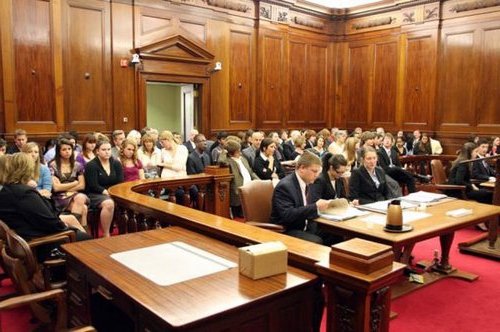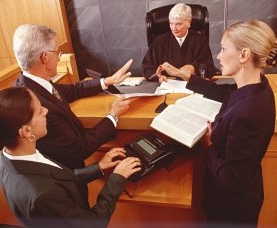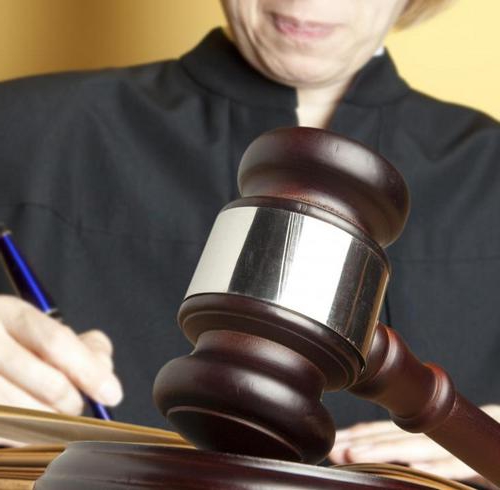The trial process takes place in the appropriate instance. The date and time of its holding are notified to the persons taking part in it. The trial may take place in the absence of interested parties in cases established by law. Next, we consider in more detail what constitutes the court and the trial.
General information
Criminal trials can take place with jury trials. The prosecutor acts as a mandatory participant in the review. The arbitration trial may take place with the participation of the board or one official. People's representatives are invited for a peer review of cases. Civil litigation is usually conducted by one official. In almost all cases except as provided by law, a secretary is involved in the review. He keeps a record. The presiding judge takes the lead in the hearing. He directs the course of consideration, provides an objective study of circumstances, excluding everything that does not relate to the essence of the dispute.
Structure
The judicial process, in accordance with the focus of the actions taken during it, is usually divided into 4 parts:
- Preparatory stage.
- Consideration of the dispute on the merits.
- Debate and conclusion of the prosecutor.
- Adoption and announcement of the decision.
All stages of the trial have their own purpose, content and a set range of issues.
Training
During this stage of the trial, the presiding judge announces the case to be considered. After that, the secretary speaks. He reports which of the invited persons is present, whether the summons were presented to the unappeared, as well as the reasons for the absence. The presiding officer shall establish the identities of those who have appeared, the credentials of representatives and officials are verified. An interpreter may also be involved in civil litigation. At the beginning of the consideration, his duties and rights are explained to him. In case of failure to appear for no good reason, the translator may be held administratively liable. Witnesses are removed from the courtroom prior to their interrogation. 
Clarification of duties and rights
During the preparatory part, the presiding officer announces composition of the court, announces the prosecutor, expert, public representative, secretary, translator. Persons who participate in the case are explained their rights. In particular, this is an opportunity to challenge. The grounds for it are established in Art. 17-21 GPK. If the petition to challenge one judge or the entire composition is satisfied, the case will be examined in the same instance, but by other officials. If the formation of a different composition is not possible, the case shall be transferred to another authorized body. After clarification of duties and rights, the judge finds out whether the parties to the dispute have any statements and petitions.
Failure to appear
At the end of the preparatory part, it becomes possible to conduct a civil trial in the absence of any of the summoned persons. If one or another invited person does not appear, the consideration of the case is postponed. Moreover, the law provides for the possibility of conducting a trial in the absence of any of those called. This is allowed if the reasons for the failure to appear are unknown or found to be disrespectful or if the defendant delays the proceedings intentionally. Parties may also request that the trial proceed in their absence. Copies of the decision in this case will be sent to them by mail. 
Merits of the dispute
After the preparation, the trial continues with the report of the chairperson or people's representative. During the speech, a general description of the case is given. The speaker reports who and to whom the lawsuit was filed, sets out the requirements of the application, the grounds for their occurrence. In the case of written objections from the defendant, they are also read. After that, it becomes clear whether the plaintiff supports his claims and to what extent. Then it is established whether the defendant agrees with the stated requirements.
Further, the speaker appeals to the participants with a proposal to complete the trial by a settlement. If the parties express a desire to end the examination in this way, then before accepting the plaintiff’s refusal of claims, the presiding judge shall explain the consequences of these actions. Without fail, the court must inform the parties of the impossibility of subsequently filing an identical claim. The plaintiff’s refusal, the terms of the agreement, the defendant’s recognition of the requirements are recorded in the protocol. These actions may be expressed as separate statements. These documents are attached to the case. 
Face explanations
During the consideration of the dispute, a substantive survey of those participating in it is carried out. The sequence of taking explanations is fixed in Art. 160 GIC. First of all, the plaintiff and the third party participating on his part are speaking. After this, the other parties give explanations. During this process, participants have the right to ask questions to each other. Explanations are usually given orally.
Debate of the parties
This part of the process summarizes the investigation of the evidence in the case. Debate is a sequential statement by the participants. During this process, an opinion is expressed about which facts should be recognized as established, which are not, and whether the requirement is subject to satisfaction. The sequence in which the parties appear is established by Art. 185 Code of Civil Procedure. First, the word is given to the plaintiff and representative, then to the defendant and his agent. Third parties act depending on which side they are involved in. Plenipotentiaries from government bodies, public organizations, trade unions, and the prosecutor, who have declared demands to protect the interests of other citizens, are the first to debate. The right to the last remark always belongs to the defendant and the representative from him. 
The opinion of the prosecutor
It is done after the debate. The conclusion on the merits of the dispute must be substantiated and substantive. The prosecutor must evaluate the evidence presented. In conclusion, he indicates what circumstances should be considered established, what norms must be applied, whether the stated requirements are subject to satisfaction, and to what extent, and also what the content of the decision should be. In cases where the prosecutor initiates the hearing, he speaks in a meeting twice. The first time he supports the requirements, and the second - gives an opinion on the merits.
Important point
The prosecutor and participants in the debate cannot invoke evidence that has not been investigated by the court. If during the speeches it becomes necessary to conduct a study of new circumstances that are relevant in the dispute under consideration, a determination is made to resume production. After examining the newly presented evidence, the debate is again heard in a general manner, and then the opinion of the prosecutor is issued. 
Decision-making
After the conclusion of the debate and the announcement of the prosecutor’s opinion, the court leaves for deliberation. The chairman announces this to all those present in the hall. In accordance with Art. 193 Only a judge and lay assessors may participate in a meeting. In case of violation of the rules on secrecy, the decision may be reversed.During the meeting, under the chairmanship of the chairman, issues that arose during the proceedings are discussed and resolved. At the end of the procedure, a decision is made. With the particular complexity of the case, the formulation of a reasoned decision can be carried out within three days. However, the court is obliged to announce the operative part at the same meeting where the consideration was completed.
The specifics of the regulation
The decision should be based solely on the evidence that was investigated during the proceedings. An authorized person on internal conviction analyzes and evaluates the arguments and establishes which of the facts should be considered proven, which law should be followed in resolving the dispute. The judge also determines how costs are to be distributed between the parties to the dispute. 
Execution of the decision
The decision may be written by the chairperson or one of the people's assessors. The decision is adopted by a majority vote. All judges who participated in the discussion and drafting of the act must sign the decision. None of the authorized persons are allowed to abstain from voting. The presiding judge shall be the last to express his opinion. Each of the judges has the right to attach his own special conclusion to the case if he does not agree with the point of view of the others. This opinion is attached to the materials, but is not announced in the hall. A decision adopted by a majority of votes shall be read out aloud to all present participants in the case by the chairperson or one of the assessors. After that, the contents, rules and terms of appeal of the act are explained to all participants. At this court hearing declared closed.



